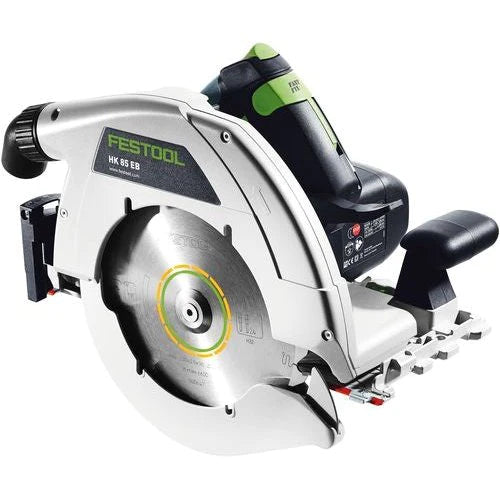Having the right Festool sander makes all the difference in the results and efficiency of your project. Festool offers a complete range of sanders designed to function perfectly with the specific materials and applications required, from fine finishing to heavy material removal. This guide should help walk you through the available options to enable you to determine the sander that aligns with your project requirements.
Reuben's Notes: The sanders in this article as described are the models available in New Zealand.
Understanding Festool's Sander Lineup
Orbital Sanders for Fine Finishing

- ETS EC 150/5 and ETS EC 150/3: These are the go-to models when it comes to multi-purpose Festool sanders. With the brushless EC-Tec motors giving major advantages in smoothness and service intervals (no need to change brushes). These sanders also deliver excellent ergonomics and a low profile, bringing you closer to your work with more comfort than ever before. The difference between the 150/3 (3mm) and the 150/5 (5mm) is in the stroke (orbit diameter). The 5mm version delivers faster working, while the 3mm version delivers slower working but a more controlled pace to your sanding. The 5mm variant is the best choice for almost everyone working with timber or fibreglass. The 3mm version is best for solid-surface materials and body shops.
- ETS 150/5 and ETS 150/3: Traditional motors make these very similar to their EC counterparts as far as performance is concerned. However, you are greeted with a much heavier and higher profile sander that makes some work more tiring and uncomfortable, sanding something overhead or vertical for example. You also have the trade-off of shorter service intervals as the brushes will wear out overtime as is standard with a traditional motor. They are however a cheaper sander and a great place to start in the Festool lineup. Some people prefer the heft of these sanders compared to their lighter-weight EC counterparts.
- ETS 125: Similar to the ETS 150 series but with a 125mm (5”) pad, the ETS 125 is ideal for people who prefer a smaller, lighter sander.
Reuben’s Notes: My choice from this range is the ETS EC 150/5 as I prefer a lightweight and lower-profile sander that bring me closer to my work. I prefer the 5mm orbit as it bring faster working and a quicker result. The 3mm orbit version is awesome for body shops where there is no room for error, however I have found the 5mm version to be more than sufficient for finishing timber. The choice between the EC brushless and non-EC brushless depends on your preference for being closer to the work with a more ergonomic and lightweight sander versus your price-consciousness.
Versatile Rotex Sanders for Multiple Applications

All Rotex series sanders are geared sanders that can be switched between the standard eccentric sanding mode and a geared Rotex mode. They also all have polishing accessories available, making them ideal for start to finish, stripping to polishing. The Rotex series has high sandpaper-availability.
- Rotex RO 150: The Rotex RO 150 is ideal for jobs that require a combination of rough sanding then intermediate or fine finishing. With the ability to switch between rough sanding mode for stripping old paint, finishes and weathering to fine sanding mode to prepare for your new surface finish (paint, varnish, oil etc.), the Rotex 150 is one of the most versatile sanders on the market.
- Rotex RO 125: Taking the switchable gearing and powerful motor from the RO 150 and scaling it down to a 125mm (5”) pad makes this ideal for people who prefer a lighter machine and makes it especially ideal for stripping old pain off weatherboard houses, then getting it ready for new paint. It is ideal for this as the 125mm pad makes it only 5mm larger than the exposed width of a standard weatherboard in New Zealand, allowing for excellent performance, ideal pad-cooling and near dustless performance.
- Rotex RO 90: The RO 90 takes the same Rotex concept and scales it down to Ø90mm while also adding a 93mm delta sanding pad (similar to multitool sanding sheets), making it an extremely versatile addition to your toolkit. Ideally suited for getting into awkward and hard to reach areas such as door frames, window frames and the underside lip of weatherboards.
Reuben’s Notes: Choosing from this range is very application specific. For general sanding (stripping to finishing) I would choose the RO 150 as it has better coverage and a larger stroke, making it a faster sander. For stripping weatherboard houses or if you are more comfortable with a smaller sander, the RO 125 is the go-to as it is only 5mm larger in diameter than the exposed face of a weatherboard, allowing for excellent performance and dust extraction. Finally, the RO 90 is my choice for door and window frames and smaller detail work. Also excellent for polishing car headlights.
Delta and Rectangular Sanders for Detailed Work

The DTS 400 and RTS 400 are corded orbital sanders with a 2mm stroke and high sandpaper-availability.
- DTS 400: The DTS sander is a Delta sander (also known as a “mouse” sander) and is ideal for getting into awkward spaces where a standard circular or rectangular sander just won’t fit.
- RTS 400: The RTS sander is a rectangular sander with a pad measuring 80x133mm. Same driveline as the DTS 400, just with a rectangular pad which some people prefer and is better suited for flat work.
Reuben’s Notes: If I was choosing one of these sanders to start with, I would choose the DTS 400 as it is a more versatile sander, allowing for sanding of non-90° corners, while still having excellent coverage in pad size.
Cordless / Hybrid Sanders for Unmatched Mobility

This range is a very interesting one, giving the ability to run corded or cordless suing either the Ergo mains adapter or the Ergo 3.1 batteries, this is a seriously versatile series of sanders. High sandpaper-availability.
- DTSC 400: Almost identical to the standard DTS 400 but with the option to run corded or cordless. Also running a brushless EC-Tec motor with better efficiency and longevity.
- RTSC 400: Almost identical to the standard RTS 400 with the same benefits as the DTSC.
- ETSC 125: Almost identical to the standard ETS 125 With the same benefits as the DTSC and RTSC
Reuben's Notes: If you are looking for a delta or rectangular sander, these are a really good way to go. As at the time of writing, packaging these with the mains adapter, they are a very similar price to the standard DTS or RTS sander discussed above, while delivering the opportunity to grab some batteries and switch over to cordless if need be.
Belt Sander for Large Surface Areas

The BS 75 and its variants are ideal for sanding large areas such as table-tops and floors, however, is not as versatile as a random orbital or an orbital due to the large space required to use the machine. Festool sandpaper for this machine is low – medium availability in NZ, however it suits paper from other manufacturers.
- BS 75: The BS 75 is an icon for heavy-duty sanding, using the sanding frame, even an un-skilled hand can avoid gouging or damaging the surface that is being worked on, with bristles that keep the edges of the machine elevated, it is almost impossible to make a mistake while levelling a surface. Awesome for levelling small floor spaces and medium-large tabletops and other flat surfaces.
Reuben’s Notes: The BS 75 suits several standard off-the-shelf belts, including those from Hikoki (prev. Hitachi). Just make sure to grab one that is 75mm wide and 533mm in circumference.
Factors to Consider
When choosing a Festool sander, consider the following factors:
- Type of Project: Define whether you're doing fine finishing, detailed work, or heavy material removal.
- Ergonomics and Weight: For extended use, comfort becomes crucial. Lightweight and ergonomically designed sanders can reduce fatigue.
- Power Source: Decide between the mobility of a cordless sander and the consistent power of a corded model.
- Dust Extraction: Festool's commitment to dust extraction improves cleanliness and health safety. Ensure your chosen sander can connect to a dust extractor.
- Budget: Budget is important to factor in when it comes to picking the right tool for the job, sometimes it’s not worth buying the highest-end tool if you are not going to use it often, however the opposite is true if you are.
Making Your Choice
Understanding the intended use and specific strength of each Festool sander model ensures you will be able to get the right one—often exceeding your expectations with high-quality results for your woodwork or finishing projects. Whether you're in search of an all-purpose tool that can cater to a great deal of work, or a specialised tool for the perfect finish, or detail work, Festool has an answer designed to perfection for both exceptional performance and excellent finish quality.
Reuben’s Note: Please feel free to get in touch with us if you have any questions about Festool sanders.


